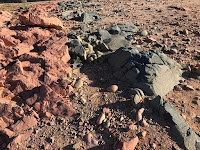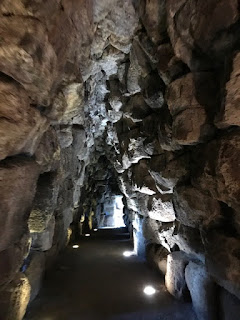I have a random question. How did Stone Age people cut their fingernails and toenails? One of the tiny but really useful things in my lifetime has been the invention of, or widespread availability of, those nail-clipper things. I can remember struggling with so-called nail-scissors for years, with their curved blades. But they can only have been around for a couple of hundred years or so, as a gadget. What came before that? Plain knife blades? Teeth? Bits of obsidian?
Muravera is a long thin town on the south side of a river which runs into an opening valley on the south east corner of Sardinia. It is curtailed by mountains behind it, and the river and green lands in front. There is a twin town - Villaputzu on the other side of the valley. The farms grow citrus fruits on the lower reaches, and the higher lands seem to be richly but randomly planted with olives, nuts, eucalyptus, oaks, wild woods.
The beaches are the main tourist attraction, and they have nothing except fine sparkly sand and a duckboard running along at the top. We saw one little jellyfish - medusa! - drifting about. Looked the same as the ones in the bay at Arbatax. My cunning wheeze - to take a bottle of tap water with us to the beach, to heat in the sun while we swim - is a great success in my opinion. You can simply wash the salt off before you dry and change back into your clothes - makes for a more comfortable day. However we should have taken an umbrella with us… it was ferociously hot. The sand was really too hot to walk on.
We found a plasticky cafe by Spiaggio San Giovanni. Our macchiato coffee was unusual being mostly milk - a dialect misunderstanding. One hunky bloke was sunbathing...
We sort-of noticed that at some point all the locals drifted away. What they knew and we did not is that the glamorous and spinky resto - further along - would rapidly fill up for lunch. We got there too late! Reservations only. It was Sunday after all! So instead we drove back along the watercourse (not seeing any flamingoes in the spagno) and eventually found a local place at the back of the town, no glamour and not many punters but a decent little lunch - eel pie, pasta with smoked fish for one and little ravioli stuffed with swordfish, bottarga (fish roe) and tomatoes. All for 38€.
Later we drove round to the intriguingly named Porto Corallo which is just a modern yacht basin with no-one there. One boat made us laugh.
We had an ice-cream before heading back to Muravera. The bridge over the river in the valley is a memorable thing - concrete at each end and rusty green metal in the middle, presumably built after the war to pre-war designs. It’s very narrow and has traffic lights.
A further note about Sardinian bread. We have - on this last but one day - found a brand of packaged focaccio bread, which comes in mini-packs. It’s pretty tasteless and dry but actually better than a lot of what we bought as ‘fresh’ in various shops. Would recommend. Focaccelle.
As you can tell, this was a lazy day. I did some drawings, we managed to get the manager of the apartments to unlock the washing machine (she was 40 mins late for the appointment), and did not much. Odd how long it takes to unwind. Back at home, Brexit rolls along like a never-ending hurricane, and the threat of flooding in the creek caused some alarms, but the Environment Agency were on the case. (FB is a strong tie). It’s so hot and bright here, it’s really hard to imagine cold dark days. But we are going home tomorrow. Then on to Ireland for Alex’s 4th birthday party.


















































